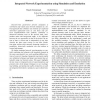Free Online Productivity Tools
i2Speak
i2Symbol
i2OCR
iTex2Img
iWeb2Print
iWeb2Shot
i2Type
iPdf2Split
iPdf2Merge
i2Bopomofo
i2Arabic
i2Style
i2Image
i2PDF
iLatex2Rtf
Sci2ools
TRIDENTCOM
2005
IEEE
2005
IEEE
Integrated Network Experimentation using Simulation and Emulation
Discrete-event packet-level network simulation is well-known and widely used. Network emulation is a hybrid approach that combines real elements of a deployed networked application—such as end hosts and protocol implementations—with synthetic, simulated, or abstracted elements—such as the network links, intermediate nodes and background traffic. A key difference between the two approaches is that in the former, the notion of time is virtual and is independent of real time, whereas the latter must execute in real time. Emulation gains realism while naturally foregoing complete repeatability; historically, emulation was also tedious to control and manage. We define integrated network experimentation as spatially combining real elements with simulated elements in the same experimental run, each modeling different portions of a network topology. Integrated experiments enable new validation techniques and larger experiments than obtainable using real elements alone. This paper high...
| Added | 25 Jun 2010 |
| Updated | 25 Jun 2010 |
| Type | Conference |
| Year | 2005 |
| Where | TRIDENTCOM |
| Authors | Shashi Guruprasad, Robert Ricci, Jay Lepreau |
Comments (0)

